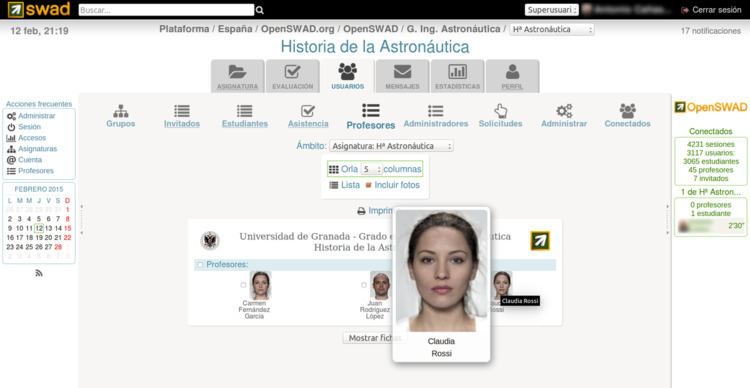Original author(s) Written in C, C++ | Developer(s) SWAD development team Operating system | |
 | ||
Stable release 16.132.11 / February 1, 2017; 53 days ago (2017-02-01) Type Course management system | ||
SWAD (originally stood for "Sistema Web de Apoyo a la Docencia" in Spanish or "Web System for Education Support", currently stands for "Shared Workspace At a Distance") is a web application to manage the courses, students and teachers of one or more educational institutions.
Contents
History
The first version of SWAD appeared in September 1999. In 2005 its use was extended to the University of Granada. The application was released as free software in January 2010 under Affero General Public License, version 3. In 2010 the system was used by 1,100 professors and 35,000 students. In 2011 it was used by 2,000 professors and 60,000 students in 2,800 courses.
SWAD is currently available in 9 languages and used in the University of Granada and the portal OpenSWAD.org. In February 2016 SWAD installation at the University of Granada housed 419 degrees (including undergraduate and graduate) with 7114 courses, 110057 students and 3304 teachers.
Server
SWAD core is a CGI programmed in C comprising almost all the functionality of the platform. The core is supplemented with some external programs like photo processing module and chat module.
The server runs on a Linux system with Apache and a MySQL or MariaDB database.
Clients
Being a web application, the client can be any modern web browser. To use the chat you must have Java runtime environment.
Besides the web client, there is an M-learning application for Android devices called SWADroid, which implements some of the most used features in the web version.
Hierarchical organization
SWAD can accommodate in a single platform one or multiple educational organizations. It uses the following hierarchical structure:
The central element of this hierarchy is the course, which can register several teachers and students.
Roles
Each user has a role of student or teacher at each of the course in which he/she is enrolled. In addition, some users may be administrators of one or more degrees, or superusers (global administrators of the platform).
